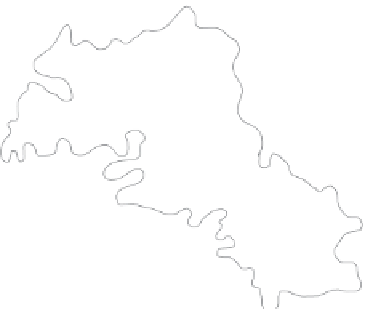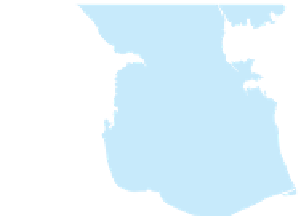Geography Reference
In-Depth Information
interests in Transylvania, and some Hungarians continue
to look upon the region as territory that has been illegiti-
mately lost. White explains how important territory is
to a nation: “The control and maintenance of territory
is as crucial as the control and maintenance of a national
language, religion, or a particular way of life. Indeed, a
language, religion or way of life is diffi cult to maintain
without control over territory.” In the case of Romania
and Hungary, as in other similar situations, territory is as
important as “language, religion, or way of life.” When
multiple nations or states claim attachments to the same
piece of territory, the potential for confl ict is signifi cant.
Another complication that arises from the lack of fi t
between nations and states is that some nations do not have
a state; they are
stateless nations
. The Palestinians are an
example of a stateless nation. The Palestinian Arabs have
gained control over the Gaza Strip and fragments of the
Occupied Territories of the West Bank and Golan Heights.
These territories may form the foundations of a future
state. The United Nations Agency for Palestinian Refugees
records 4.9 million registered Palestinian refugees. Well
over half of the registered Palestinian refugees continue
to live in Jordan, Lebanon, Syria, and other Arab states.
Nearly 2 million Palestinians live in the Gaza Strip and
West Bank; however, the international community does
not universally recognize the Palestinian lands as a state.
A much larger stateless nation is the Kurds whose
population of between 25 and 30 million live in an area
called Kurdistan that covers parts of six states (Fig. 8.6). In
the aftermath of the 1991 Gulf War, the United Nations
established a Kurdish Security Zone north of the 36th
parallel in Iraq, and that area continues to have signifi -
cant autonomy in present-day Iraq. The no-fl y zone in the
Kurdish region of northern Iraq has created a relatively
peaceful place compared to continued violence in south-
ern Iraq. Violent acts still mar the Kurdish north, but
prosperity has also come to the region through petrodol-
lars. An October 2008 travel article in the
New York Times
described new theme parks and gated communities that
refl ect the affl uence in the city of Erbil, which is the Kurd-
ish capital city in Iraq. The article also described Erbil's
6000-year-old citadel as a reminder that the city is “one
of the oldest continuously inhabited cities in the world.”
An independent Kurdish state seems unlikely, at
least in the near future. In addition to northern Iraq, the
Kurds form the largest minority in Turkey where the city
of Diyarbakir is the unoffi cial Kurdish capital of Turkey.
Relations between the 10 million Kurds in Turkey and
the Turkish government in Ankara have been volatile, and
Turkey regards the Kurdish region as part of the state's
core territory. Without the consent of Turkey, establish-
ing a truly independent Kurdish state will be diffi cult.
European Colonialism and the Diffusion
of the Nation-State Model
Europe exported its concepts of state, sovereignty, and
the desire for nation-states to much of the rest of the
world through two waves of colonialism (Fig. 8.7). In the
Figure 8.6
Kurdish Region of the Middle East.
35
°
40
°
45
°
50
°
55
°
GEORGIA
Black
Sea
© H. J.
40
°
de Blij, P. O. Muller, and John Wiley & Sons.
AZERBAIJAN
ARMENIA
Caspian
Sea
40
°
AZERBAIJAN
Lake
Van
TURKEY
Lake
Urmia
35
°
IRAN
Lake
Tharthar
35
°
SYRIA
LEBANON
Lake
Rassazah
IRAQ
JORDAN
MIDDLE EAST
Kurdish majority
30
°
Lake
Hammar
SAUDI
ARABIA
0
100
200 Kilometers
Persian
Gulf
0
50
100
150 Miles
45
KUWAIT
40
°
Longitude East of Greenwich
°
50
°






























































































































